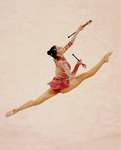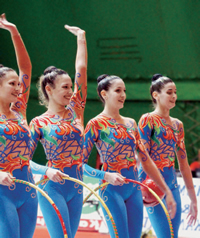
Greek Rhythmic Gymnasts Take the Stage
Front-Center
In just a few decades, Greece has developed an award-winning team
in this up and coming Olympic sport




(HCS)--While some of Greece's "Golden Girls" were receiving quite a bit of media attention last year at the Athens 2004 Olympic Games, another team of Greek women athletes were also competing at the highest levels internationally. Rhythmic gymnasts who had earned top international awards over the last couple of years, put years of training on the line during the summer games.
The unexpected emergence of these Greek women among the world's top-ranking teams has drawn global admiration. Thanks to their dedication and the efforts of their coaches, these young women presented a strong team, competing favorably with Russian, Bulgarian, and other gymnasts. Although they didn't win the top medals last year as they had hoped, their performance nonetheless made many take notice.
Greece has been a relative new-comer in the field of rhythmic gymnastics. Fielding their first team in 1987, just one decade before earning first-place awards in world competitions, is remarkable. For years the Russian and Eastern European teams had dominated this sport, but in the late 80's Spain and Greece emerged to win medals, ushering in a new stage in the international scene. In 1999, Greece won the European Championships, taking first place in the All-Around, the Clubs, and the Hoops and Ribbons Competitions; the team competed dancing to Mikis Theodorakis' "Zorba" and "Dance of the Swords" by Aram Hatsurian. Later that same year, the team bested a number of other countries to bring home gold medals in the Clubs and Hoops and Ribbons. Since that time, Greece has continued to field strong teams. In fact, according to Greek experts, the Greek rhythmic gymnastics team has won more awards than any other Greek sports team.
Not a small amount of credit is due the coaches and trainers of the Greek team. Mrs. Eleni Polychronidou organized the first team in 1987 and led them to a sixth-place win at the European Youth Championships that year, dancing to the traditional Greek 'Karagouna.' Two years later, under the guidance of Bulgarian coach, Mrs Irina Ilieva, the Greek team won 5th place in the World Rhythmic Gymnastics Championships in Sarajevo. Russian coach Marina Fateeva was hired in 1999 to work with the women's team, in cooperation with Polychronidou who trained the youth group. Herself an Olympic competitor, Polychronidou can be credited with launching the sport in Greece and bringing award-winning Greek teams to the international arena.
Although popular for some time in Europe, rhythmic gymnastics has only recently developed a following here in the U.S. It differs from traditional gymnastics in that apparati (clubs, (hoops, ribbons, clubs and balls) are incorporated into music-accompanied dance routines without acrobatics. Competitions may be either individual or group, in which 5 members of a team perform in a routine. According to a U.S. expert, Ralitsa Kalmukova, a former member of one of the world's top-rated teams in Bulgaria, the sport is rapidly gaining in popularity here. Just recently, she organized the first Rhythmic Gymnastics Show in the Boston area. And with another former member of the renowned Bulgarian groups, she has established a school in the Northeast that offers lessons in several locations throughout New England.
Kalmukova points out the benefits of rhythmic gymnastics training for youngsters. For starters, it aids development in agility, flexibility, strength, coordination--especially hand-eye coordination--not to mention confidence, discipline, and creativity. The sport incorporates elements of ballet, dance, and gymnastics with creativity and musical expression. Rhythmic gymnasts perform with balls, clubs, hoops, and ribbons. What makes it attractive and beautiful to the viewer, she asserts, are the "dazzling tosses and difficult catches, combined with high leaps, jumps, difficult flexibility skills, and graceful pirouettes." But it's great for women of any age, since participants can shape up and develop firm tone, all while expressing themselves uniquely and creatively.
For Greek-Americans, though, this sport may prove particularly attractive, in light of the performances of the Greek teams to Greek traditional music. Instead of other sports like field hockey and soccer, this one could confer many of the same physical and developmental benefits while incorporating elements from Greek folk dance. Just imagine it, twenty-five hundred years after the Golden Age of Greece, our own young Greeks developing agility, strength, and coordination to the same rhythmns as their ancient forebears--and for the same reasons!
For more information about Ms. Kalmukova, who is also a cancer researcher at MIT, or about Rhythmic Gymnastics, contact her directly at ralitsak@mit.edu. HCS has reproduced a promotional flyer for her new gymnastics school as a courtesy to readers at http://www.helleniccomserve.com/rhythmgymschool.html. Ms. Kalmukova recommends that interested readers view several websites dedicated to rhythmic gymnastics at http://www.rsgvideos.com or http://www.gymuniverse.com.

2000 © Hellenic Communication Service, L.L.C. All Rights Reserved.
http://www.HellenicComServe.com